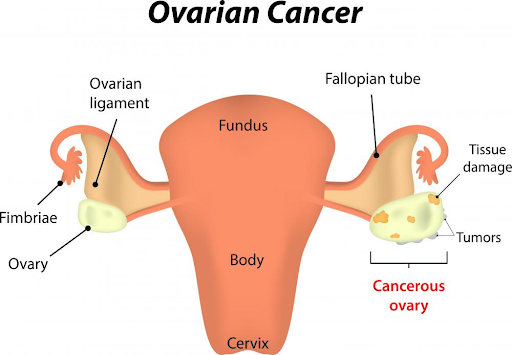

Ovarian Cancer
Ovarian cancer is the second most common gynecologic cancer in the United States. Ovarian cancer causes more deaths than any other cancer of the female reproductive system. Researchers have known that African-American women with ovarian cancer, on average, do not survive as long as non-Hispanic White patients with the disease.

What to Know
Ovarian cancer is one of the most fatal cancers diagnosed in women in the United States (U.S.). Data shows racial/ethnic differences in risk and survival of epithelial ovarian cancer with higher incidence among white women yet worse survival among African-American women compared to other racial/ethnic groups. Data also suggest that socioeconomic factors and access to care contribute to the disparity in ovarian cancer survival among African-American women.
The American Cancer Society estimates for ovarian cancer in the United States for 2023 are:
About 19,710 women will receive a new diagnosis of ovarian cancer.
About 13,270 women will die from ovarian cancer.
-
Age
-
Obesity
-
Not having children or having children later in life
-
Hormone therapy after menopause
-
Family history of ovarian, breast cancer or colorectal cancer
-
Smoking
Ovarian Cancer Risks
Signs and Symptoms
-
Bloating
-
Pelvic or abdominal (belly) pain
-
Trouble eating or feeling full quickly
-
Urinary symptoms such as urgency (always feeling like you have to go) or frequency (having to go often)
-
Fatigue (extreme tiredness)
-
Upset stomach
-
Back pain
-
Pain during sex
-
Constipation
-
Changes in a woman's period, such as heavier bleeding than normal or irregular bleeding
-
Abdominal (belly) swelling with weight loss

What is Ovarian Cancer?
Ovaries are reproductive glands found only in females (women). The ovaries produce eggs (ova) for reproduction. The ovaries are also the main source of the female hormones estrogen and progesterone. One ovary is on each side of the uterus.
Ovarian cancer is a cancerous tumor of an ovary. It may originate from the ovary itself or more commonly from nearby structures such as fallopian tubes.
The ovary is made up of three different cell types including epithelial cells, germ cells, and stromal cells






